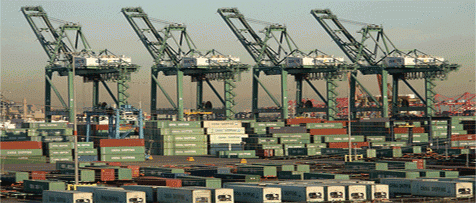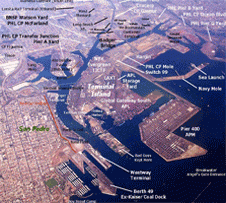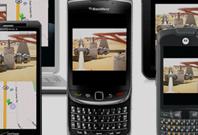

Improving Security Responsiveness at the Nation’s Busiest Cargo Port
A Critical Challenge:
The Port of Los Angeles, Southern California’s gateway to international commerce, is located in San Pedro Bay, just 20 miles south of downtown Los Angeles. This booming seaport not only sustains its competitive edge with record‐setting cargo operations, but is also known for its progressive security measures, groundbreaking environmental initiatives, and diverse recreational and educational facilities.
The Port encompasses 7500 acres, 43 miles of waterfront and features 27 cargo terminals, including dry and liquid bulk, container, break‐bulk, automobile and omni facilities. Combined, these terminals handle almost 190 million metric revenue tons of cargo annually. Last year, the Port moved an impressive 8.5 million Twenty‐foot Equivalent Units (TEUs), establishing a new national container record. The Port is also home to the nation’s most secure cruise passenger complex, the World Cruise Center.
The Ports of Los Angeles and Long Beach take an integrated, multi‐agency approach to port security. Using a layered approach to security, the port works closely with the US Coast Guard, Customs and Border Protection, and Department of Homeland Security, as well as state, county and local law enforcement, under a coordinated system of difference security measures at various levels that ensure there are protective measures in place throughout the Port, on both water and land.
As one of the few police forces in the nation dedicated exclusively to 24‐hour port activities, the Los Angeles Port Police are responsible for patrol and surveillance of the port of Los Angeles and neighboring Harbor Area communities. As California peace officers, the Port Police enforce federal, state and local public safety statutes as well as environmental and maritime safety regulations. Highly regarded among specialized law enforcement agencies, the primary goal of the Port Police is to maintain the free flow of commerce and produce a safe, secure environment that promotes uninterrupted Port operations.
Considering that nearly 45% of all imports into the United States come through the combined Los Angeles/Long Beach Harbor Complex, Port Police officers have a daunting job. The Port is an important economic engine, not only to Southern California, but also to the country. “Domain Awareness” is the name of the game in protecting one of the nation’s largest port complexes. But with 43 miles of water front and 14 square miles of heavy industrial complex, it is nearly impossible to have visibility to all the critical infrastructure areas of the Port. Video surveillance systems provide a force‐multiplier and coupled with mobile video collaboration and other tools, they allow a more limited number of officers the ability to view potential threats for assessment and response.
A Key Part of the Solution:
The Port of Los Angeles has implemented an intricate network of surveillance and access control systems throughout the Port improving its overall Domain Awareness, Incident Management, Interagency Coordination and Communications, and Field Operations and Communications. RealityVision was a key part of the overall goals of the Port’s Integrated Command and Control System (ICCS), Water Side Security System (WSSS) and ALERT systems by delivering technology that allowed the
Port to:
- Make video and access control system images and information available to field officers via cellular communications network
- Use GIS and GPS to add geo‐referenced perspective to map and display locations of incidents and police resources (Blue Force Tracking)
- Using web access to share incident information with other emergency operations centers or other agencies.
Reality Mobile and its RealityVision product demonstrated a technology that would provide accurate transmission of images using cellular technology. The images that are transmitted by RealityVision are clear and readable. Via the RealityVision solution, Port Police are able to send and receive video to/from the field. Additionally, the GPS tagging capabilities (bread‐crumb trails) of RealityVision give the ICCS the ability to identify, on a map, where videos are taken. With GPS, it also gives the Port the ability to implement “Blue Force Tracking” so that Port Police vehicle and vessel locations can be tracked in GIS mapping. Port Police use the RealityVision platform for transmitting much of the GPS locations via a Sprint cellular network. This allows the ICCS to dynamically map the locations of Port Police and other first responder resources throughout the port complex.
Performance Measures:
While it is difficult to measure the efficacy of public safety solutions, it is important and useful to put into context the importance of domain awareness in the Los Angeles port complex. Given the scope of operations in the Port of Los Angeles, it is likely near impossible to provide response and security 24/7 to 43 miles of water front and 14 square miles of heavy industrial complex. Through the Port’s WSSS system they have improved coverage for monitoring the complex via video surveillance and access control systems, of which RealityVision is an important component. The ICCS and the RealityVision feature in particular, will also improve other key areas of public safety and security.
Faster Video Deployment:
Remote video provides additional video surveillance capabilities when and where they are needed. No longer is it necessary to anticipate each location where surveillance is required. Remote video devices can be deployed anywhere at any time. Furthermore, field forces have almost immediate access to WSSS video feeds through the ICCS/RealityVision network.
Real Time Monitoring of Asset Location:
GPS solutions provide the capacity to track where Port Police assets are located in real time.
Improved Communications:
Communications are improved with diversified communications network and remote video cellular transmission. Using the RealityVision solution provides another layer to the communications network. It also provides information and visualization in real‐time thereby removing the second‐guessing that could otherwise occur in determining true situational circumstances.
The solution deployed delivers real‐time domain awareness not only in the operations center but also in the field – it leverages proven technologies in video surveillance with emerging technologies in cellular video transmission.

